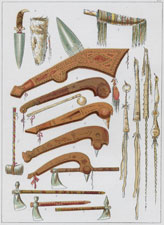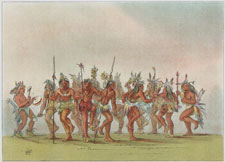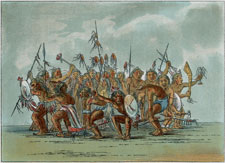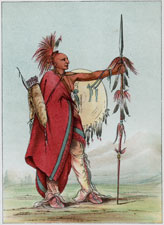Since Adirondack Retro acquired Darvill's Rare Prints in August of 2022, we have been working tirelessly on our New State-Of-The Art Website. We are excited to announce that it is now up and running and that our massive inventory of Antique Prints and Rare Maps are being transferred over to the new site daily. In addition to the nearly 500,000 prints found on www.DarvillsRarePrints.com, Adirondack Retro offers an eclectic selection of Antique and Vintage Advertisements along with their Limited Edition Giclee Prints. During this transition, customers will still be able to shop and make purchases on www.DarvillsRarePrints.com. Sign up for our Mailing List and receive our Adirondack Retro Newsletter. When you sign up, we will email you a coupon code for you to get 15% OFF your first order at AdirondackRetro.com. |
Illustrations of the Manners, Customs, & Condition of the
North American Indians. With Letters and Notes, Written during
Eight Years of Travel and Adventure among the Wildest and
Most Remarkable Tribes Now Existing. By George Catlin.
Published by Chatto & Windus, Piccadilly, London
(1876)
Original Color Lithographs (chromolithographs) over 140 years old!
Sheet size: approximately 6 1/8 x 9 3/8 inches
[also available are the 1845 black & white engravings]
George Catlin's paintings comprise the first important pictorial record of the Plains Indians and their then little-known homelands west of the Mississippi River. "Catlin's Indian Gallery," as the dedicated artist himself called it, consisted of hundreds of portraits of Indians, scenes of Indian life, and landscapes of a wilderness scarcely changed through the millennia. In his notebooks and on canvas, the young Pennsylvania lawyer captured much of an American that was swept away a century ago by the westward-pressing settler.
Catlin made these dramatic paintings on a series of journeys into largely unmapped Indian country between 1830 and 1836. For the first time, Americans in the eastern states saw the Pawnees, the tall Blackfeet and Crows, the Sioux, and the wild Comanches. They saw wide prairies teeming with buffalo, the turbulent Missouri River, and the giant grizzly bear. They saw villages of hundreds of graceful teepees and peered into the dim interiors of comfortable earth lodges, and witnessed the four-day torture ceremony of the Mandans.
The Plains Indians of Catlin's portraits were still proud and dignified, unlike their cousins on eastern reservations. Freed by the acquisition of the horse from the restrictions of hunger and scarcity, they were riding the crest of a new richness and power.
But they, too, were fated to lose in the encounter with western civilization—and Catlin knew it. "Art may mourn when these people are swept from the earth," he wrote, "and the artists of the future ages may look in vain for another race so picturesque in their costumes, their weapons, their colours, their manly games, and their chase...."
[ref.: "Letters and Notes..." introduction by Marjorie Halpin (Dover, 1973).]

George Catlin
as painted by William Fisk, 1849
"I sat out alone, unaided and unadvised, resolved, (if my life should be spared), by the aid of my brush and my pen, to rescue from oblivion so much of their primitive looks and customs as the industry and ardent enthusiasm of one lifetime could accomplish."
GEORGE CATLIN, ca. 1842
(Colors represented on individual computer monitors will vary and may not accurately depict the actual lithographic color on the prints.)
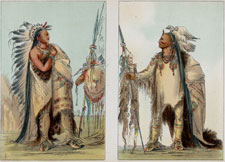
(click thumbnail to enlarge)
Plates 77-78
Pa-ris-ka-roo-pa, Two Crows
Ee-he-a-duck-chee-a, He Who Ties His Hair Before
$95
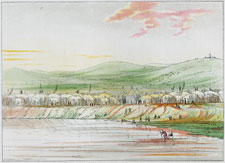
(click thumbnail to enlarge)
Plate 80
Arikara Village of earth-covered lodges above St. Louis
$95

(click thumbnail to enlarge)
Plates 81-82
Kah-beck-a, the Twin
Stan-au-pat, Bloody Hand
$95

(click thumbnail to enlarge)
Plates 83-84
Pah-too-ca-ra, He Who Strikes
Pshan-shaw, Sweet-scented Grass
$95

(click thumbnail to enlarge)
Plate 85
Fort Pierre, mouth of Teton River

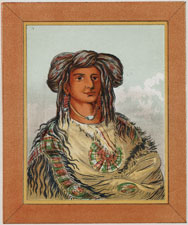
(click thumbnail to enlarge)
Plate 86
One Horn, head chief of the Miniconjou
$95
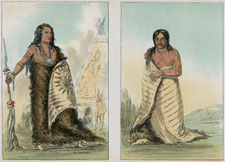
(click thumbnail to enlarge)
Plates 87-88
Shoo-de-ga-cha, Smoke, chief of the tribe
Hee-la'h-dee, Pure Fountain, wife of Smoke
$95
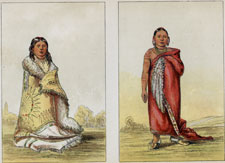
(click thumbnail to enlarge)
Plates 89-90
Mong-shong-shaw, Bending Willow
Hongs-kay-de, Great Chief, son of Smoke
$95
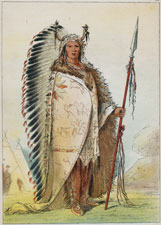
(click thumbnail to enlarge)
Plate 91
Ee-ah-sa-pa, Black Rock

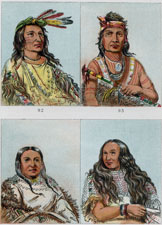
(click thumbnail to enlarge)
Plates 92-95
Tchan-dee, Tobacco
Toh-ki-e-to, Stone with Horns
Wi-looh-tah-eeh-tchah-ta-mah-nee, Red Thing That Touches in Marching
Ychon-su-mons-ka, Sand Bar, wife of the trader, Francois Chardon
$95
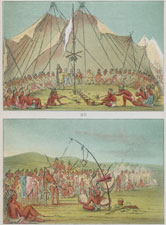
(click thumbnail to enlarge)
Plates 96-97
Sioux Dog Feast
Self-torture in Sioux Cermony
$95

(click thumbnail to enlarge)
Plate 101
Methods of scalping and use of scalps

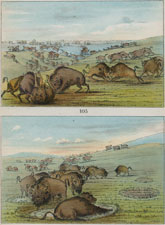
(click thumbnail to enlarge)
Plates 105-106
Buffalo bulls in running season
Buffalo bull in his wallow

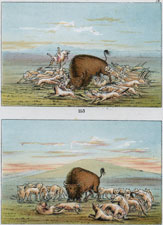
(click thumbnail to enlarge)
Plates 113-114
White wolves attacking buffalo
White wolves attacking buffalo
$95
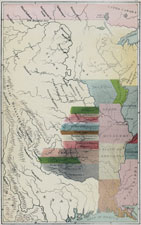
(click thumbnail to enlarge)
U. States Indian Frontier in 1840.
Shewing [sic] the Positions of the Tribes that have been removed west of the Missisippi [sic].
$95
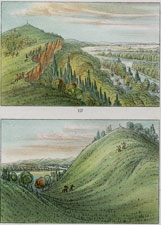
(click thumbnail to enlarge)
Plates 117-118
Blackbird's Grave
Floyd's Grave
$95
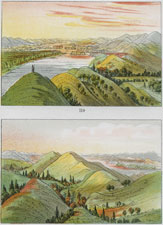
(click thumbnail to enlarge)
Plates 119-120
Grassy river bluffs above St. Louis
Grassy river bluffs above St. Louis
$95
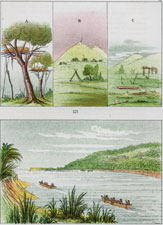
(click thumbnail to enlarge)
Plates 121-122
Indian burial customs
"Belle Vue," the Indian agency of Major Dougherty

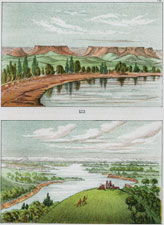
(click thumbnail to enlarge)
Plates 123-124
The "Square Hills"
Mouth of the Platte River
$95

(click thumbnail to enlarge)
Plates 125-126
Batiste [sic], Bogard and Catlin approaching buffalo
Buffalo herd crossing the Missouri
$95
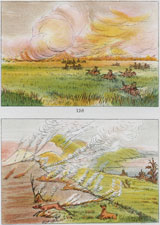
(click thumbnail to enlarge)
Plates 127-128
Prairie bluffs burning
Prairie meadow burning
$95
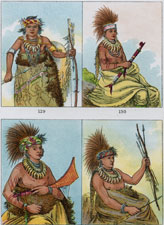
(click thumbnail to enlarge)
Plates 129-132
Notch-ee-ning-a, No Heart, called White Cloud, chief of the tribe
Wy-ee-yogh, Man of Sense
Pah-ta-coo-che, Shooting Cedar
Was-com-mun, Busy Man
$95
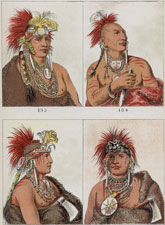
(click thumbnail to enlarge)
Plates 133-136
Sho-me-cos-se, The Wolf
Meach-o-shin-gaw, Little White Bear
Chesh-oo-hong-ha, Man of Good Sense
Wa-hon-ga-shee, No Fool
$95
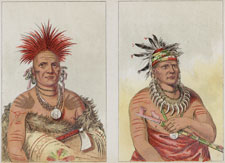
(click thumbnail to enlarge)
Plates 138-139
Shon-da-ki-he-ga, The Horse Thief, Pawnee head chief
Haw-che-ke-sug-ga, He Who Kills Osages
$95
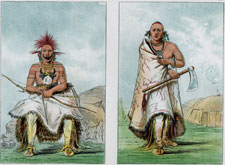
(click thumbnail to enlarge)
Plates 140-141
La-doo-ke-a, Buffalo Bull
Le-shaw-loo-lah-lee-hoo, Big Elk
$95

(click thumbnail to enlarge)
Plates 143-144
No-way-ke-sug-ga, He Who Strikes Two At Once
Raw-no-way-woh-krah, Loose Pipe-stem
$95

(click thumbnail to enlarge)
Plates 145-146
Ki-ho-ga-way-shu-shee, Brave Chief, chief of the Omaha
Om-pa-ton-ga, Big Elk
$95
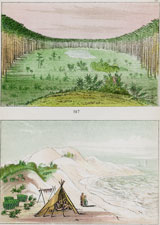
(click thumbnail to enlarge)
Plates 147-148
Beautiful savannah in the pinewoods of Florida
Seminole family drying fish on Santa Rosa Island
$95
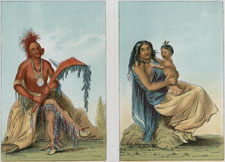
(click thumbnail to enlarge)
Plates 150-151
Clermont, head chief of the Osages
Wife and child of Clermont
$95
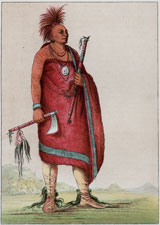
(click thumbnail to enlarge)
Plates 152
Tchong-tas-sab-bee, Black Dog
$95
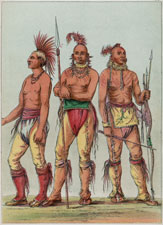
(click thumbnail to enlarge)
Plates 154-156
Ko-ha-tunk-a, Big Crow
Nah-com-e-shee, Man of the Bed
Mun-ne-pus-ke, He Who Is Not Afraid
$95
2 |

